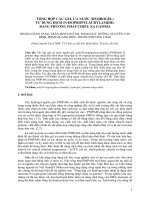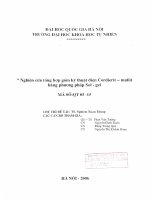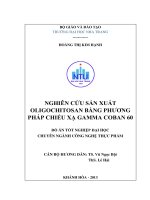Nghiên cứu tổng hợp tấm nano graphene từ oxít graphene bằng phương pháp chiếu xạ gamma co 60
Bạn đang xem bản rút gọn của tài liệu. Xem và tải ngay bản đầy đủ của tài liệu tại đây (329.46 KB, 13 trang )
ĐẠI HỌC QUỐC GIA TP.HCM
ĐẠI HỌC QUỐC GIA HÀ NỘI
PHÒNG THÍ NGHIỆM CÔNG NGHỆ NANO
TRƯỜNG ĐẠI HỌC CÔNG NGHỆ
PHẠM THỊ THU HỒNG
NGHIÊN CỨU TỔNG HỢP TẤM NANO GRAPHENE
TỪ OXÍT GRAPHENE BẰNG PHƯƠNG PHÁP
CHIẾU XẠ GAMMA Co-60
LUẬN VĂN THẠC SĨ
TP. HCM - 2015
1
ĐẠI HỌC QUỐC GIA TP.HCM
ĐẠI HỌC QUỐC GIA HÀ NỘI
PHÒNG THÍ NGHIỆM CÔNG NGHỆ NANO
TRƯỜNG ĐẠI HỌC CÔNG NGHỆ
PHẠM THỊ THU HỒNG
NGHIÊN CỨU TỔNG HỢP TẤM NANO GRAPHENE
TỪ OXÍT GRAPHENE BẰNG PHƯƠNG PHÁP
CHIẾU XẠ GAMMA Co-60
Chuyên ngành: VẬT LIỆU VÀ LINH KIỆN NANO
Mã số: Chuyên ngành đào tạo thí điểm
LUẬN VĂN THẠC SĨ
GVHD:
PGS. TS HÀ THÚC HUY
TP. HCM - 2015
2
LỜI CẢM ƠN
Em xin gửi lời cảm ơn đến PGS.TS Hà Thúc Huy. Thầy đã tận tình, chu
đáo hướng dẫn và luôn sẵn sàng giải đáp cặn kẽ các vấn đề liên quan đến luận
văn nghiên cứu này mà em còn thắc mắc, hay chưa hiểu. Đặc biệt, Em xin bày
tỏ sự kính trọng Thầy vì đã truyền đạt tinh thần ham mê nghiên cứu khoa học và
thái độ làm việc nghiêm túc.
Em xin cảm ơn đến các bạn trong phòng thí nghiệm I65- Bộ môn Hóa
polymer-Trường Đại học Khoa học Tự nhiên – Đại học Quốc gia Thành phố Hồ
Chí Minh nhiệt tình hỗ trợ trong thời gian em thực hiện thí nghiệm chế tạo Oxít
graphite.
Em xin cảm ơn đến Ban giám đốc, các đồng nghiệp tại Trung tâm Nghiên
cứu và Triển khai Công nghệ Bức xạ đã tạo điều kiện thuận lợi nhất để cho em
tham gia khóa học và nơi thực hiện phần lớn các thí nghiệm, chiếu xạ mẫu.
Em cũng xin gửi lời cảm ơn đến Ban giám đốc Phòng Thí nghiệm Công
nghệ Nano đã tổ chức khóa học này.
Cuối cùng, Tôi xin cảm ơn gia đình đã làm điểm tựu và nguồn động viên to
lớn để tôi luôn cố gắng học tập, nghiên cứu khoa học và hoàn thành luận văn
này.
Tp.Hồ Chí Minh, ngày 31 tháng 12 năm 2015.
Phạm Thị Thu Hồng
3
LỜI CAM ĐOAN
Tôi xin cam đoan đây là công trình nghiên cứu của riêng tôi, được thực
hiện dưới sự hướng dẫn khoa học của PGS. TS Hà Thúc Huy.
Các số liệu và kết quả nghiên cứu trong luận văn này là trung thực.
Tp.Hồ Chí Minh, ngày 31 tháng 12 năm 2015.
Phạm Thị Thu Hồng
4
MỤC LỤC
No table of contents entries found.DANH MỤC CÁC BẢNG
Trang
Bảng 3. 1: Nhận danh các đỉnh đặc trưng trên phổ FTIR của GO ............... Error!
Bookmark not defined.
Bảng 3. 2: Nhận danh các đỉnh đặc trưng trên phổ FTIR của Monoglyceride
............................................................................. Error! Bookmark not defined.
Bảng 3. 3: So sánh tỉ lệ cường độ đỉnh D (ID ) và G (IG) của graphite, GO và
RGOE chiếu xạ ở nồng độ ethanol và liều xạ khác nhauError! Bookmark not
defined.
5
DANH MỤC HÌNH VẼ VÀ ĐỒ THỊ
Trang
Hình 1. 1 Mẫu than chì ....................................... Error! Bookmark not defined.
Hình 1. 2 Các dạng thù hình của carbon [35] ..... Error! Bookmark not defined.
Hình 1. 3 Đơn nguyên tử graphene (khoảng 30-40 lớp) được quan sát dưới ảnh
hiển vi điện tử quét .............................................. Error! Bookmark not defined.
Hình 1. 4 Ô mạng cơ sở của graphene................ Error! Bookmark not defined.
Hình 1. 5 Cấu trúc của GO ................................. Error! Bookmark not defined.
Hình 1. 6 Sự hình thành dimanganheptoxid (Mn2O7) từ KMnO4 trong môi
trường axít mạnh [12] .......................................... Error! Bookmark not defined.
Hình 1. 7 Sơ đồ một ví dụ về qui trình khử GO chế tạo graphene bằng bức xạ
gamma [13].......................................................... Error! Bookmark not defined.
Hình 1. 8 Cấu trúc hóa học của Monoglyceride . Error! Bookmark not defined.
Hình 1. 9 Quy trình tổng hợp Graphene từ GraphiteError!
defined.
Bookmark
not
Hình 1. 10 Máy quang phổ hấp thu UV-Vis, JASCO V630, Nhật Bản ...... Error!
Bookmark not defined.
Hình 1. 11 Sự nhiễu xạ tia X bởi các mặt phẳng mạngError! Bookmark not
defined.
Hình 1. 12 Máy nhiễu xạ tia X, D8 ADVANCE Error! Bookmark not defined.
Hình 1. 13 Máy chụp ảnh TEM, JEM 1010 ....... Error! Bookmark not defined.
Hình 1. 14 Thiết bị đo điện trở mặt 4 đầu dò Lucas Labs Division/QuadPro
S302-8 ................................................................. Error! Bookmark not defined.
Hình 2. 1 Quy trình tổng hợp Oxít graphite từ graphite theo phương pháp
Hummers ............................................................. Error! Bookmark not defined.
Hình 2. 2 Huyền phù GO sau khi tổng hợp ........ Error! Bookmark not defined.
6
Hình 2. 3 GO sau khi sấy khô (trái) và nghiền mịn (phải)Error! Bookmark not
defined.
Hình 2. 4 Sơ đồ qui trình xử lý GO với nước cấtError! Bookmark not defined.
Hình 2. 5 Sơ đồ qui trình xử lý GO với hỗn hợp ethanol/nước cất ............. Error!
Bookmark not defined.
Hình 2. 6 Sơ đồ qui trình xử lý GO với Monoglyceride/ethanol ................ Error!
Bookmark not defined.
Hình 2. 7 Sơ đồ qui trình chiếu xạ các hệ GON, GOE và GOM bằng bức xạ
gamma ................................................................. Error! Bookmark not defined.
Hình 2. 8 RGOE (trái) và RGOM (phải) được lắng rửa bằng nước cất ...... Error!
Bookmark not defined.
Hình 2. 9 RGOE (trái) và RGOM (phải) sau khi sấy khôError! Bookmark not
defined.
Hình 3. 1 Phổ FTIR của graphite........................ Error! Bookmark not defined.
Hình 3. 2 Phổ FTIR của GO ............................... Error! Bookmark not defined.
Hình 3. 3 Phổ FTIR của Monoglyceride ............ Error! Bookmark not defined.
Hình 3. 4 Phổ FTIR của GO và RGON chiếu xạ 0; 13,5; 25,7; 38,8 và 57,8 kGy
tại nồng độ GO là 1 mg/ml trong nước cất. ........ Error! Bookmark not defined.
Hình 3. 5 Phổ FTIR của RGOE theo dải liều xạ 0; 10,4; 23,5; 38,8 và 50 kGy tại
nồng độ GO là 1 mg/ml trong dung dịch ethanol 25 % (v/v).Error! Bookmark
not defined.
Hình 3. 6 Phổ FTIR của RGOE theo nồng độ ethanol 12,5; 25 và 50 % (v/v).
Chiếu xạ 10,4 kGy ở nồng độ GO 1 mg/ml. ....... Error! Bookmark not defined.
Hình 3. 7 Phổ FTIR của Monoglyceride và RGOM chiếu xạ 0; 10,4; 23,5 và 50
kGy tại nồng độ GO là 1 mg/ml trong dung dịch ethanol 25 % (v/v). ........ Error!
Bookmark not defined.
Hình 3. 8 Phổ UV-Vis của hệ GON chiếu xạ (a) từ 0 - 57,8 kGy tại nồng độ GO
là 1 mg/ml trong nước cất và ảnh chụp (b) (tại nồng độ pha loãng 0,025 mg/ml)
............................................................................. Error! Bookmark not defined.
Hình 3. 9 Phổ UV-Vis của hệ GOE (a), GOM (b) theo dải liều xạ và ảnh chụp
hệ GOE (c), GOM (d). Tại nồng độ GO là 1 mg/ml, ethanol 25 % (v/v). ... Error!
Bookmark not defined.
7
Hình 3. 10 Phổ UV-Vis của GOE theo nồng độ ethanol: 12,5; 25 và 50 % (v/v).
Chiếu xạ tại 10,4 kGy ở nồng độ GO là 1 mg/ml.Error!
Bookmark
not
defined.
Hình 3. 11 Phổ UV-Vis của GOE25 theo nồng độ GO 0,5; 1 và 2 mg/ml tại liều
xạ 23,5 kGy và nồng độ ethanol 25 % (v/v) ....... Error! Bookmark not defined.
Hình 3. 12 Phổ Raman của graphite, GO và RGOE chiếu xạ 23,5; 38,8 và 50
kGy. ..................................................................... Error! Bookmark not defined.
Hình 3. 13 Giản đồ TGA của graphite, GO và RGOE 38,8 và 50 kGy. ..... Error!
Bookmark not defined.
Hình 3. 14 So sánh độ giảm khối lượng của graphite, GO, RGOE 38,8 và 50
kGy trong các khoảng nhiệt độ khác nhau. ......... Error! Bookmark not defined.
Hình 3. 15 Giản đồ DSC của graphite, GO, RGOE -50 kGyError!
not defined.
Bookmark
Hình 3. 16 Giản đồ XRD của graphite và GO.... Error! Bookmark not defined.
Hình 3. 17 Giản đồ XRD của GO và RGOE chiếu xạ 23,5 và 50 kGy ...... Error!
Bookmark not defined.
Hình 3. 18 Ảnh TEM của RGOE tại liều xạ 0 kGy (a, b) và 50 kGy (c,d) . Error!
Bookmark not defined.
Hình 3. 19 Ảnh chụp của dung dịch GO, RGOE (50 kGy) để ổn định sau 1 tuần,
nồng độ mẫu 0,1 mg/ml....................................... Error! Bookmark not defined.
Hình 3. 20 Độ dẫn điện của RGOE theo liều xạ 0; 23,5; 38,8 và 50 kGy .. Error!
Bookmark not defined.
8
9
TÀI LIỆU THAM KHẢO
Tài liệu tiếng Việt
1. Nguyễn Phương Tố Linh, Khảo sát quá trình tổng hợp graphene từ
graphite oxide thông qua hai giai đoạn biến tính và khử. 2014, Trường Đại
học Khoa học Tự nhiên, Đại học Quốc gia Thành phố Hồ Chí Minh.
2. Mai Thanh Tâm, Biến tính đất sét bằng hợp chất nonion mới và ứng dụng
tổng hợp nanocomposite trên nền thermoplastic urethan (TPU). 2009,
Trường Đại học Khoa học Tự nhiên, Đại học Quốc gia Thành phố Hồ Chí
Minh.
3. Bách khoa toàn thư mở Wikipedia. Than chì.
/>
Available from:
Tài liệu tiếng Anh
4. A. Esaeili, M.H.Entezari (2014), “Facile and fast synthesis of graphene
oxide nanosheets via bath ultrasonic irradiation”, Journal of Colloid and
Interface Science 432, pp. 19-25.
5. Ansón-Casaos, A., et al. (2014), “The effect of gamma-irradiation on fewlayered graphene materials”, Applied Surface Science 301, pp. 264-272.
6. An, S.J. (2010), “Thin film fabrication and simultaneous anodic reduction
of deposited graphene oxide platelets by electrophoretic deposition”, J.
Phys. Chem. Lett. ,1, pp. 1259-1263.
7. Arco, L.G.D. (2010), “Continuous, highly flexible, and transparent
graphene films by chemical vapor deposition for organic photovoltaics”,
ACS Nanomaterials and their Applications 4, pp. 2865.
8. Attila Ve´ rtes, Sa´ndor Nagy, Zolta´n Klencsa´r, Rezso˝ G. Lovas, Frank
Ro¨ sch (2011), Handbook of Nuclear Chemistry, Springer, USA.
9. Bowu Zhang, Linfan Li., et al. (2012), “Radiation induced reduction: an
effective and clean route to synthesize funtionalized graphene”, Journal of
Materials Chemictry 22, pp. 7775-7781.
10. Chao Xu, Ru-sheng Yuan, Xin Wang (2014), “Selective reduction of
graphene oxide”, New Carbon Materials 29(1), pp. 61–66.
11. Daniela C. Marcano, D.V.K., Jacob M. Berlin (2010), “Improved synthesis
of graphene oxide”, ACS Nano 4 (8), pp. 4806-4814.
10
12. Daniel R. Dreyer (2010), “The chemistry of graphene oxide”, Chemical
Society Reviews 39(1), pp. 228.
13. Dumée, L.F., et al. (2014), “Tuning the grade of graphene: Gamma ray
irradiation of free-standing graphene oxide films in gaseous phase”,
Applied Surface Science 322, pp. 126-135.
14. Fan, Z. (2010), “An environmentally friendly and efficient route for the
reduction of graphene oxide by aluminum powder”, Carbon 48, pp. 16861689.
15. Han Mai-Xing, Ji Zhuo-Yu, et al. (2011), “γ radiation caused graphene
defects and increased carrier density”, Chin. Phys. B 20 (8) 086102.
16. Hassan A. AbdEl-Rehim, E.-S.A.H., and Ahmed Raafat (2011), “Radiation
processing of active biodegradable green nanocomposite materials for
packaging purposes”. Report of the 1st RCM on Radiation Curing of
Composites for Enhancing the Features and Utility in Health Care and
Industry, Vienna, pp. 62-77.
17. Il Tae Kim, A.M., Karl Jacob (2013), “Synthesis and electrochemical
performance of reduced graphene oxide/maghemite composite anode for
lithium ion batteries”, Carbon 52, pp. 56-64.
18. Jung, J.-M., et al. (2014), “Rapid, facile, and eco-friendly reduction of
graphene oxide by electron beam irradiation in an alcohol–water solution”,
Materials Letters 126, pp. 151-153.
19. Kwon, Y.J., et al. (2014), “Improvement of gas sensing behavior in reduced
graphene oxides by electron-beam irradiation”, Sensors and Actuators B:
Chemical 203, pp. 143-149.
20. Kaner, D.L.A.R.B., Graphene-based meterials. Materials Science, 2008.
21. Lert, A. (1998), “Structure of graphite oxide revisited”, J. Phys. Chem. B, p.
102.
22. Li, J., et al. (2014), “γ-ray irradiation effects on graphene oxide in an
ethylenediamine aqueous solution”, Radiation Physics and Chemistry 94,
pp. 80-83.
23. Lin, Y.-M. (2010), “100 GHz Transistors from Wafer Scale Epitaxial
Graphene”, Science 327, pp. 662.
24. Liu, J., L. Cui, and D. Losic (2013), “Graphene and graphene oxide as new
nanocarriers for drug delivery applications”, Acta Biomaterialia 9 (12), pp.
9243-9257.
11
25. Liu, L.F.A.Z. (2011), “Graphene in biomedicine: opportunities and
challenges”, Nanomedicine 6 (2), pp. 317-324.
26. Martín, A. and A. Escarpa (2014), “Graphene: The cutting–edge interaction
between chemistry and electrochemistry”, TrAC Trends in Analytical
Chemistry 56, pp. 13-26.
27. Mermin, N.D. (1968), “Crystalline order in two dimensions”, Physical
Review 176, pp. 250-254.
28. Noh, Y.-J., et al. (2014), “High-performance polymer solar cells with
radiation-induced and reduction-controllable reduced graphene oxide as an
advanced hole transporting material”, Carbon 79, pp. 321-329.
29. Novoselov, K.S. (2004), “Electric field effect in atomically thin carbon
films”, Science 306, pp. 666.
30. Novoselov, K.S. (2005), “Two-Dimensional Gas of Massless Dirac
Fermions in Graphene”, Nature Communications 438, pp. 197-200.
31. Park, M., et al. (2013), “Facile preparation of graphene induced from
electron-beam irradiated graphite”, Materials Letters 105, pp. 236-238.
32. Pierson, H.O. (1993), Handbook of carbon, graphite, diamond and
fullerenes - Properties, processing and applications, Noyes 43-67, p. 226242.
33. Pierson, H.O. (1993), Handbook of carbon, graphite, diamond and
fullerenes -Properties, processing and applications, Noyes 43-67: p. 226242.
34. R. Muszynski, B.S., and P. V. Kamat (2008), “Decorating graphene sheets
with gold nanoparticles”, J. Phys. Chem. C 112, pp. 5263-5266.
35. Royal Swedish Academy of Sciences (2010), Scientific Background on the
Nobel Prize in Physics 2010 GRAPHENE,
36. Stankovich, S. (2006), “Graphene-based composite materials”, Nature
Communications 442, pp. 282–286.
37. S. Ruoff, S.P.A.R. (2009), “Chemical methods for the production of
graphenes”, Nat. Nanotech 4, pp. 217-224.
38. Virendra Singh (2011), “Graphene based materials: Past, present and
future”, Progress in Materials Science 56(8), pp. 1178-1271.
12
39. Wang, Z.-g., et al. (2014), “The green synthesis of reduced graphene oxide
by the ethanol-thermal reaction and its electrical properties”, Materials
Letters 116, pp. 416-419.
40. William S. Haummers, J., Richard E. Offeman (1958), “Preparation of
graphitic oxide”, J Am Chem Soc 80 (6), pp. 1339.
41. Wu, J.Q., et al. (2013), “Effects of X-ray irradiation on the structure and
field electron emission properties of vertically aligned few-layer graphene”,
Nuclear Instruments and Methods in Physics Research Section B: Beam
Interactions with Materials and Atoms 304, pp. 49-56.
42. Wang, G.X. (2008), “Facile synthesis and characterization of graphene
nanosheets”. J. Phys. Chem. C 112, pp. 8192-8195.
43. Sampath, G.K.R.A.S. (2009), “Electrochemical reduction of oriented
graphene oxide films: An in situ Raman spectroelectrochemical study”, J.
Phys. Chem. C 113, pp. 7985-7989.
44. Stobinski, L.(2014), “ Graphene oxide and reduced graphene oxide studied
by the XRD, TEM and electron spectroscopy methods”, Journal of
Electron Spectroscopy and Related Phenomena 195, pp. 145-154.
45. Shichoon Lee, Sung Hun Eom, et al. (2013), “Large-scale production of
high-quality reduced graphene oxide”, Chemical Engineering Journal 233,
pp. 297-304.
46. Vorrada Loryuenyong, Krit Totepvimarn, et al. (2013), “Preparation and
Characterization of Reduced Graphene Oxide Sheets via Water-Based
Exfoliation and Reduction Methods”, Advances in Materials Science and
Engineering, pp. 1-5
47. Yang, N. (2010), “Two-dimensional graphene bridges enhanced
photoinduced charge transport in dye-sensitized solar cells”, ACS
Nanomaterials and their Applications 4, pp. 887.
48. Zhu, Y. (2010), “Graphene and Graphene Oxide: Synthesis, Properties, and
Applications”, Advanced Materials 22(35), pp. 3906-3924.
49. Zhu, Y. (2010), “Graphene and graphene oxide: Synthesis, properties, and
application”, Advanced Materials xx, pp. 1-19.
50. Tam T. Mai, Chi Nhan Ha Thuc and Huy Ha Thuc (2014), “Preparation of
Graphene Nano-Layer by Chemical Graphitization of Graphite Oxide from
Exfoliation and Preliminary Reduction”, Fullerenes, Nanotubes and
Carbon Nanostructures 23, pp. 742-749.









